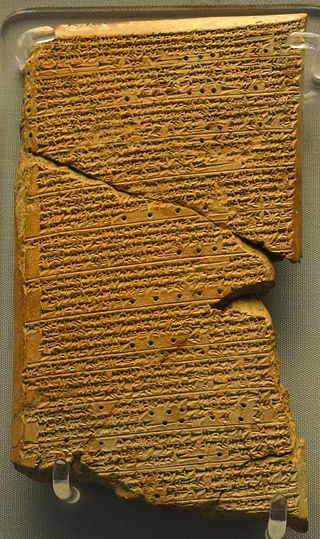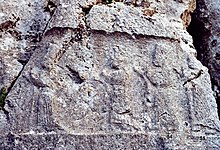
Ninḫursaĝ sometimes transcribed Ninursag, Ninḫarsag, or Ninḫursaĝa, also known as Damgalnuna or Ninmah, was the ancient Sumerian mother goddess of the mountains, and one of the seven great deities of Sumer. She is known earliest as a nurturing or fertility goddess. Temple hymn sources identify her as the "true and great lady of heaven" and kings of Lagash were "nourished by Ninhursag's milk". She is the tutelary deity to several Sumerian leaders.
Ninlil was a Mesopotamian goddess regarded as the wife of Enlil. She shared many of his functions, especially the responsibility for declaring destinies, and like him was regarded as a senior deity and head of the pantheon. She is also well attested as the mother of his children, such as the underworld god Nergal, the moon god Nanna or the warrior god Ninurta. She was chiefly worshiped in Nippur and nearby Tummal alongside Enlil, and multiple temples and shrines dedicated to her are attested in textual sources from these cities. In the first millennium BCE she was also introduced to Ḫursaĝkalamma near Kish, where she was worshiped alongside the goddess Bizilla, who was likely her sukkal.
Zababa was the tutelary deity of the city of Kish in ancient Mesopotamia. He was a war god. While he was regarded as similar to Ninurta and Nergal, he was never fully conflated with them. His worship is attested from between the Early Dynastic to the Achaemenid periods, with the Old Babylonian kings being particularly devoted to him. Starting with the Old Babylonian period, he was regarded as married to the goddess Bau.

Zarpanitu was a Mesopotamian goddess regarded as the spouse of Marduk. Not much is known about her character, though late sources indicate that she was associated with pregnancy and that she could be assigned similar roles as her husband, including that of queen of the gods. She was originally worshiped in Zarpan, a village near Babylon, though the latter city itself also served as her cult center.

Nisaba was the Mesopotamian goddess of writing and grain. She is one of the oldest Sumerian deities attested in writing, and remained prominent through many periods of Mesopotamian history. She was commonly worshiped by scribes, and numerous Sumerian texts end with the doxology "praise to Nisaba" as a result. She declined after the Old Babylonian period due to the rise of the new scribe god, Nabu, though she did not fully vanish from Mesopotamian religion and attestations from as late as the neo-Babylonian period are known.

Nanaya was a Mesopotamian goddess of love closely associated with Inanna.
Aya was a Mesopotamian goddess associated with dawn. Multiple variant names were attributed to her in god lists. She was regarded as the wife of Shamash, the sun god. She was worshiped alongside her husband in Sippar. Multiple royal inscriptions pertaining to this city mention her. She was also associated with the Nadītu community inhabiting it. She is less well attested in the other cult center of Shamash, Larsa, though she was venerated there as well. Additional attestations are available from Uruk, Mari and Assur. Aya was also incorporated into Hurrian religion, and in this context she appears as the wife of Shamash's counterpart Šimige.
Ninegal or Belat Ekalli (Belet-ekalli) was a Mesopotamian goddess associated with palaces. Both her Sumerian and Akkadian name mean "lady of the palace."
Ninimma was a Mesopotamian goddess best known as a courtier of Enlil. She is well attested as a deity associated with scribal arts, and is variously described as a divine scholar, scribe or librarian by modern Assyriologists. She could also serve as an assistant of the birth goddess Ninmah, and a hymn describes her partaking in cutting of umbilical cords and determination of fates. It has also been suggested that she was associated with vegetation. In the Middle Babylonian period she additionally came to be viewed as a healing deity.
Šulpae was a Mesopotamian god. Much about his role in Mesopotamian religion remains uncertain, though it is agreed he was an astral deity associated with the planet Jupiter and that he could be linked to specific diseases, especially bennu. He was regarded as the husband of Ninhursag. Among the deities considered to be their children were Ashgi, Panigingarra and Lisin. The oldest texts which mention him come from the Early Dynastic period, when he was worshiped in Kesh. He is also attested in documents from other cities, for example Nippur, Adab and Girsu. Multiple temples dedicated to him are mentioned in known sources, but their respective locations are unknown.

Ninkarrak was a goddess of medicine worshiped chiefly in northern Mesopotamia and Syria. It has been proposed that her name originates in either Akkadian or an unidentified substrate language possibly spoken in parts of modern Syria, rather than in Sumerian. It is presumed that inconsistent orthography reflects ancient scholarly attempts at making it more closely resemble Sumerian theonyms. The best attested temples dedicated to her existed in Sippar and in Terqa. Finds from excavations undertaken at the site of the latter were used as evidence in more precisely dating the history of the region. Further attestations are available from northern Mesopotamia, including the kingdom of Apum, Assyria, and the Diyala area, from various southern Mesopotamian cities such as Larsa, Nippur, and possibly Uruk, as well as from Ugarit and Emar. It is possible that references to "Ninkar" from the texts from Ebla and Nikarawa, attested in Luwian inscriptions from Carchemish, were about Ninkarrak.
Shuzianna was a Mesopotamian goddess. She was chiefly worshiped in Nippur, where she was regarded as a secondary spouse of Enlil. She is also known from the enumerations of children of Enmesharra, while in the myth Enki and Ninmah she is one of the seven minor goddesses helping with the creation of mankind.

Ninsianna was a Mesopotamian deity considered to be the personification of Venus. This theonym also served as the name of the planet in astronomical texts until the end of the Old Babylonian period. There is evidence that Ninsianna's gender varied between locations, and both feminine and masculine forms of this deity were worshiped. Due to their shared connection to Venus, Ninsianna was associated with Inanna. Furthermore, the deity Kabta appears alongside Ninsianna in many texts, but the character of the relation between them remains unclear.

Sukkal was a term which could denote both a type of official and a class of deities in ancient Mesopotamia. The historical sukkals were responsible for overseeing the execution of various commands of the kings and acted as diplomatic envoys and translators for foreign dignitaries. The deities referred to as sukkals fulfilled a similar role in mythology, acting as servants, advisors and envoys of the main gods of the Mesopotamian pantheon, such as Enlil or Inanna. The best known sukkal is the goddess Ninshubur. In art, they were depicted carrying staves, most likely understood as their attribute. They could function as intercessory deities, believed to mediate between worshipers and the major gods.
Urash (Uraš) was a Mesopotamian god who was the tutelary deity of Dilbat. He was an agricultural god, and in that capacity he was frequently associated with Ninurta. His wife was the goddess Ninegal, while his children were the underworld deity Lagamal, who like him was associated with Dilbat, and the love goddess Nanaya.
Laṣ was a Mesopotamian goddess who was commonly regarded as the wife of Nergal, a god associated with war and the underworld. Instances of both conflation and coexistence of her and another goddess this position was attributed to, Mammitum, are attested in a number sources. Her cult centers were Kutha in Babylonia and Tarbiṣu in Assyria.
Ninmug or Ninmuga was a Mesopotamian goddess. She was associated with artisanship, especially with metalworking, as evidenced by her epithet tibira kalamma, "metalworker of the land." She could also be regarded as a goddess of birth and assistant of Ninmah, most likely because the fashioning of statues of deities and the birth of children could be described with the same terms in Sumerian texts. Her main cult centers were Kisiga, whose location remains uncertain, and Adab.
Tadmuštum or Dadamušda was a Mesopotamian goddess associated with the underworld. She was regarded as the daughter of Nergal, and in known texts often appears in association with his main cult center, Kutha.

Epithets of Inanna were titles and bynames used to refer to this Mesopotamian goddess and to her Akkadian counterpart Ishtar. In Mesopotamia, epithets were commonly used in place of the main name of the deity, and combinations of a name with an epithet similar to these common in ancient Greek religion are comparatively uncommon. Inanna had more titles than any other Mesopotamian deity. They pertained to her associations with specific cities or areas, such as Uruk, Zabalam, Akkad, Nineveh, or the Sealand. Others instead highlighted her specific roles, for example, that of an astral goddess personifying the planet Venus—or that of a war deity. In some cases, her individual epithets eventually developed into separate deities.
Ara was a Mesopotamian goddess regarded as a servant of the god Enki. While in the past it was often assumed this theonym was only an alternate name Isimud, today the two are regarded as distinct deities who eventually came to be conflated with each other. Ara is attested in sources such as god lists, incantations and a curse formula from Malgium.








